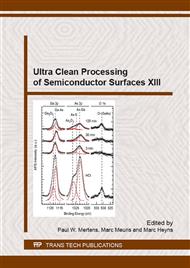p.338
p.344
p.348
p.357
p.361
p.366
p.375
p.381
p.387
Electrolyzed Water for Efficient Metal Removal
Abstract:
This work demonstrates the efficient removal of various metals from the plastic surface of wafer storage cassettes (FOUP’s) by using electrolyzed water. The studies are ruled out for Anodic water chloride. This new wet cleaning technology is a powerful application, not for FOUP’s only, but also for innovative semiconductor surface preparation and FEOL cleaning applications.
Info:
Periodical:
Pages:
375-380
Citation:
Online since:
September 2016
Price:
Сopyright:
© 2016 Trans Tech Publications Ltd. All Rights Reserved
Share:
Citation:


